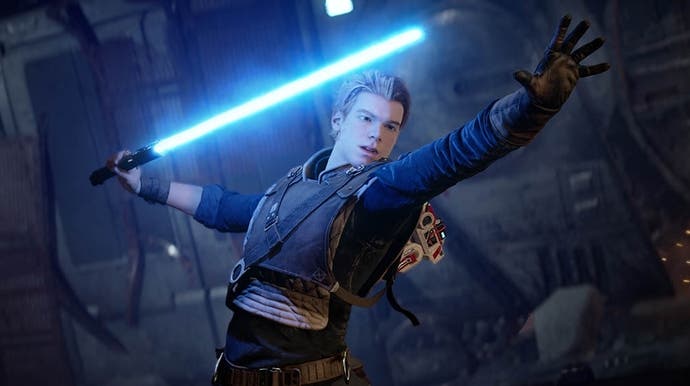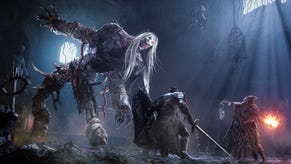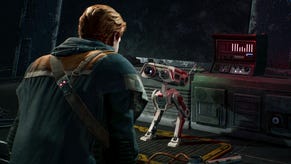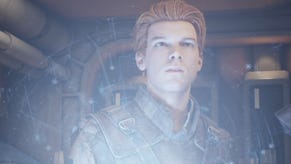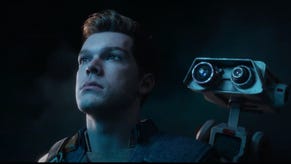Star Wars Jedi: Fallen Order's combat shows promise, but I'm yet to be wowed
Hands-on with Respawn's title at E3.
When Star Wars Jedi: Fallen Order initially revealed its gameplay demo last week, I think it's fair to say the reaction was subdued. Fans felt it was missing a certain spark, while others expressed disappointment at not being shown the promised Metroidvania-inspired gameplay. Many complained about the protagonist feeling a little boring.
The narrative of the game remains a mystery (and Cal remains a little bland), but I did get to experience some of the core combat and Metroidvania elements during a 50 minute gameplay hands-on session at E3. Like a bumbling Luke arriving on Dagobah to be trained by Yoda, I was guided through the session by lead combat designer Jason de Heras, and got to play both a "gauntlet" training mode and the second half of the previously-shown gameplay demo.
While the depth of the mechanics and variety of ways to approach combat meant I couldn't achieve the same flair as was shown in the gameplay demo, I got a better understanding of how the combat will play out, and the tactical decisions players will be required to make. Fallen Order has a deep and challenging combat system, which once mastered, will provide players with a full Jedi power trip - and the opportunity to get really creative with the combat. It's promising, yet I wasn't totally wowed, in part because I felt I'd need longer with the game to get to the stage where I could be more ambitious and develop a sense of flow. On top of that, Respawn's still keeping many of the force abilities secret, so we're not yet sure what the combat will be like in the endgame.
Oh, and I also took the opportunity to ask de Heras about the process behind the game's development, which does raise some concerns about how creative Respawn is being allowed to go with the title.

I should probably preface this preview with a couple of notes about the demo build and difficulty. Star Wars Jedi: Fallen Order provides a fair level of challenge, and in the interests of time, the second half of the demo version was set to default difficulty, but the build also had a number of additional safety net measures. de Heras told me the AI's aggressiveness had been toned down, and I also noticed I was essentially on god mode and couldn't die.
It was a shame not to get the full combat experience within the environmental setting, but I understand Respawn's reasoning here. Star Wars Jedi: Fallen Order's combat is going to take more than 20 minutes to master, and the developer obviously wanted players to experience the demo's level design and environment without stressing too much about dying.
That said, de Heras explained the first part of the demo (the gauntlet) was closer to what default difficulty should be like, and so my combat impressions are based predominantly on this part. Even on default, it's pretty challenging, but the full game will have three difficulty levels in total. To contextualise this, de Heras says Respawn is making the hard level closer to Souls-like games, and the default is a couple of steps below this.
"Difficulty's not going to be about making the AI take more hit points, as we want it to still feel like a lightsaber, so they're going to hit harder, the parry window will be smaller or bigger depending on the difficulty," de Heras explained.
"We still want to challenge the player and trust the player, but we don't want players to spend eight hours on one level," de Heras added. "So we still want to give you a challenge." I agree with this assessment - I found it challenging, but throughout the session noticed myself improving, and it felt great when things clicked.
Given the combat is a little fiddly, I asked if Respawn is including accessibility options. I was also pleased to hear that this is indeed the case, and a range of features are being added to help players (such as the camera staying farther behind the player, a more forgiving lock-on, and the ability to simply hold buttons instead of mashing). Great stuff.
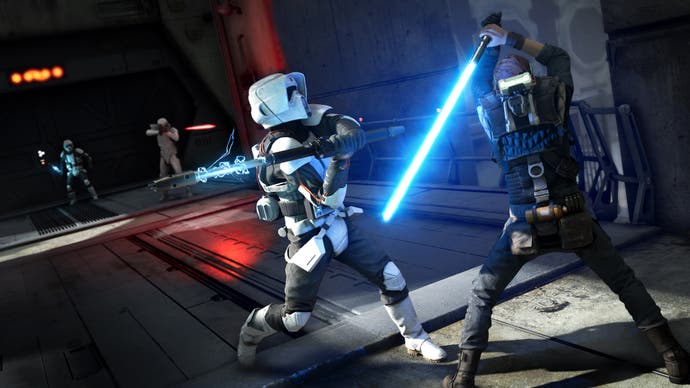
Right, time to actually dig into the combat systems. By now you'll probably have seen several articles describing how similar the combat feels to [insert FromSoftware game here], and while it may be a cliché, it's probably the easiest comparison to make. Parrying plays a large role, and following up with counter-attacks will result in some very dead Stormtroopers. Correctly timed blocks can also open up enemies to a cinematic finisher move. Blocking doesn't necessarily work in every situation, as enemies will glow red when they're about to launch an unblockable attack - in which case a dodge is required.
A little more Star Wars is the ability to deflect blaster shots, which ping backwards towards enemies like a deeply satisfying return of serve - a comparison de Heras said is actually used by the development team to describe the feeling.
For me, one of the main challenges is knowing which enemies to tackle first. You may be tempted to dive right into the fray, but often you'll have to keep an eye out for ranged blaster shots which can catch you unawares. The different enemies, meanwhile, add variety to each skirmish - and you'll have to learn their behaviours if you want to tackle them appropriately. Unless you take out a Purge Trooper quickly, they're going to be a real thorn in your side - particularly if you get caught in their extended attack. An alternative approach is to pick off all the small fry and leave them until the end, in which case dodge is going to be your friend.
There are also some particularly inventive ways to manipulate enemy targets - de Heras said it's possible to force freeze a viper probe droid as it's about to self-destruct, then force push it into a group of other enemies. Alternatively, you can use force push to shove enemies into the path of other enemies (such as pushing a Stormtrooper into one of those spiders), which de Heras explained nicely as a "temporary co-op situation".
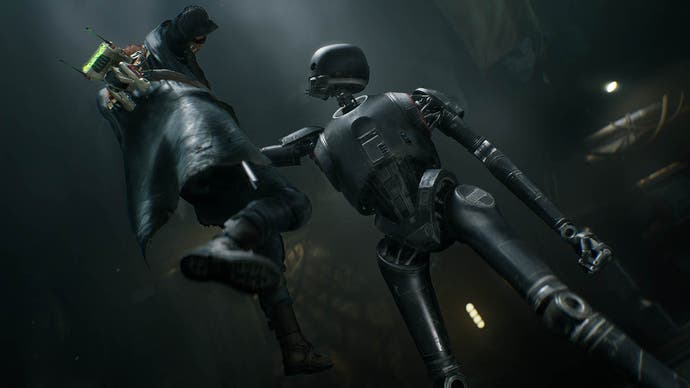
In any case, choosing the order in which to tackle enemies and how to section them is going to be an important aspect of Fallen Order's gameplay - and obviously one way to handle this is via the force abilities. Force push, force pull and force freeze (stasis) can be used as either light or heavy attacks, depending on how long you hold the respective trigger or bumper. In the case of freezing an enemy, it's possible to freeze for the entirety of the combat encounter, which is a handy sectioning mechanic.
While the force abilities allow for some genuinely interesting combinations, you can't rely on them too much, and I was surprised by how quickly the force bar drained. It only regenerates through further combat, so you can't just camp in a corner and wait (you are a Jedi, after all). I expect the thinking behind this is to balance the combat to ensure players really engage with the core fighting mechanics - however, I feel it could be a lot more fun if players were allowed to really let rip with the force abilities. These make up the most unique and creative parts of Fallen Order, and the most Star Wars parts, so I'd love to see a slight shift towards allowing more force powers.
To be fair, this is perhaps a problem that can be addressed through the skill tree, which is still something of a mystery. You may recall from our extended gameplay demo write-up that we got to see some galaxy-design meditation spots, which allow players to access the skill tree and save the game mid-level (kind of like a Souls bonfire). There are three branches to this - force, lightsaber and survivability, which allow upgrades in each of these areas. Perks such as lightsaber-throwing can be bought with XP - but you'll have to keep an eye on this skill currency, as when you die, you'll drop all this XP on the enemy that killed you.
I was wondering exactly how far you can take Cal's build in different directions using the skill tree, but from de Heras' answers, it doesn't sound hugely diverse. Balancing the skill tree is apparently the way to go (no min-maxing - that's more for the combat, apparently) and Respawn is "still determining whether we want the skill tree to be finished by the time you beat the game".
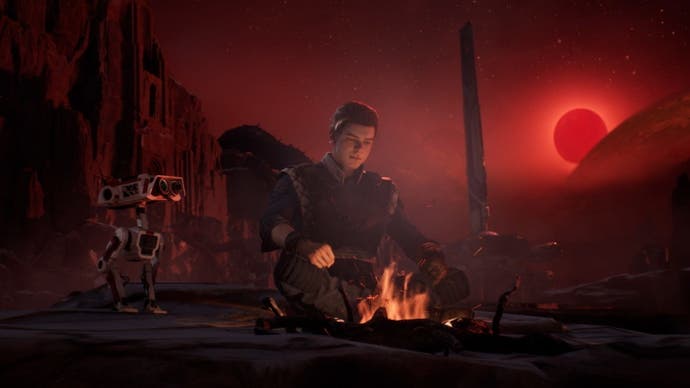
In a totally linear story, dropping your XP on an enemy wouldn't be an issue, as you'd have to continue on the same path regardless. But Fallen Order isn't a linear game. It has branching pathways, which is where the Metroidvania elements can be found. As I speculated previously, Cal and BD-1 can acquire specific skills which unlock pathways through planets and levels - and the game provides you with holographic maps to show the pathways open to you and general direction of travel. Essentially, glowing green = good, glowing red = no no.
"You'll use Cal's abilities to progressively unlock [paths] - it's kind of like a pacing matter, so you use enough of that ability in one area, and when you get a new ability you can explore more and open up more of the levels," de Heras explained. "There's that connection between your abilities and the environment - that's how we designed the game, and we're still tweaking that to make it even better."
The level design means you'll be required to re-traverse past levels after acquiring new abilities, which made me wonder how Respawn will make this engaging. I asked de Heras, who said you won't just be re-visiting the same things you've already experienced and that there "might be different encounters, or different events".
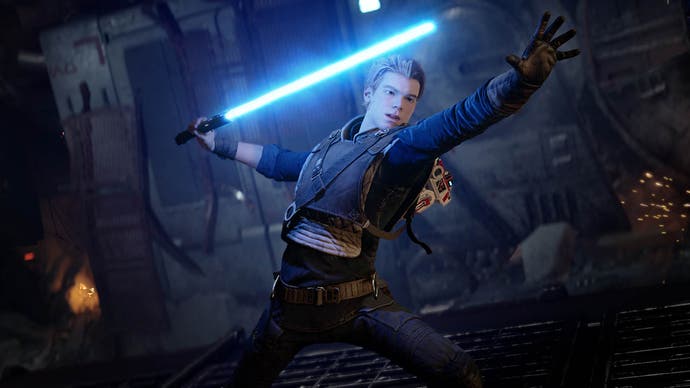
While there are a lot of positives to take away from Fallen Order, particularly the inventive ways to use abilities, I have a couple of reservations. Generally speaking, I feel Cal could have slightly better movement (even the force dash feels underwhelming), and the lock-on mechanic is sometimes a little frustrating. When two enemies were near one another, this would often latch onto the wrong one, leaving me open to attack. It's a small quibble, and a problem that's present in other Souls-like titles.
At some points, too, I did get the sense the AI felt a bit "stand around and wait"-y even in the gauntlet, so ideally I would have liked to see more diverse movement from enemies.
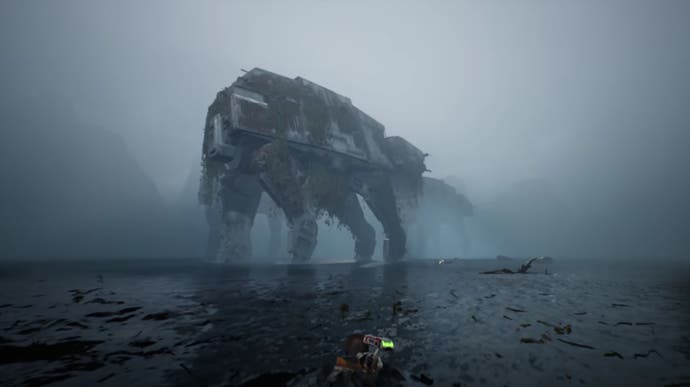
At the end of the demo, I took the opportunity to ask de Heras a couple of questions about Respawn's thinking on the project - specifically, whether designing for the game while having to "keep it canon" had restricted their creative decision-making process.
"We have to work with Lucasfilm on everything, we have to approve everything and have to collaborate with them, so there's give and take," de Heras said.
"Sometimes we want to do something that's more gameplay-driven or out the box but then we have to sit with them and find a middle ground. Same with everything - combat, exploration, story, all the departments have to collaborate. We're trying to make an authentic game, so we're trying to stay in that level. Authentic's the word."
This is the thing I'm most concerned about regarding Respawn's title. While I appreciate the dedication to Star Wars lore, and it's obviously true Fallen Order should feel like Star Wars, I'm worried this will be a game designed by committee. It's always great to have a little weirdness in Star Wars - and I worry some of Respawn's creativity could be stifled by the demands of sticking to the script. For instance, when I asked whether Respawn would introduce force abilities not seen in the films, aside from the force freeze ability stasis (which is essentially an elaboration of Kylo Ren's powers), de Heras said Respawn is "trying to stay true to what the baseline is" - so that's a no. I wonder what sort of gameplay we could have seen if Lucasfilm had fully taken their foot off the brakes. I also wonder if this is the explanation for why the main character currently feels rather uninspired.
For now, Fallen Order does seem to have a lot of potential in its combat system, and I think the force combinations, individuality of enemies and interaction with the environment is a big part of that. But I also have some reservations, and am yet to be fully bowled over by the game as a whole. Hopefully when Fallen Order is released in full, that will change.
